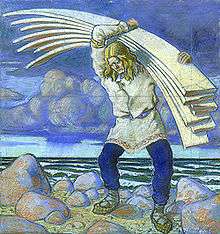Kalevi (mythology)

Kaleva - also known as Kalevi or Kalev - is an ancient Finnish ruler, known from the Finnish epic Kalevala. Kaleva and his sons are important heroic figures in Estonian, Finnish and Karelian mythology.
History
Some historians have suggested that the oldest known written reference to Kaleva (Kalev / Kalevi) can be found from the 6th or 7th century Anglo-Saxon poem Widsith, which became copied in the Exeter Book, a manuscript of Old English poetry compiled in the late 10th century. Widsith states:
"Caesar ruled the Greeks, Caelic the Finns ... I was with the Greeks and Finns and also with Caesar ..."
Some historians have interpreted the term "Caelic" in Widsith to refer to the ancient Finnish ruler Kaleva, discussed in the Finnish epic Kalevala.
The first clear written mentioning of Kaleva appears in 1641 in the Leyen Spiegel by Heinrich Stahl. [1]
The name of Estonia's national epic Kalevipoeg means "son of Kalevi" (or "son of Kalev") and the name of Finnish national epic Kalevala means "Land of Kaleva". Some have suggested that Kalevala might be the Estonian mainland. [2]
According to the 18th century Finnish folklore-collector Kristfrid Ganander, Kaleva had 12 sons in total, which included e.g. such renowned heroes as Väinämöinen, Ilmarinen and Hiisi.
Myths
In Estonian stories, sons of Kaleva were originally considered royalty. In Finnish stories though, they are more often referred to as giants who built several castles and lived in various regions of Finland. In either case, they are often blamed for oddities in nature, such as strangely large or weird stones for instance.
Myths tell that as more and more of the citizens became Christianized, their inhabitants began to hate Kaleva's sons for remaining pagans. Soon, Kaleva's sons were forced to leave their country, Kalevala. As time passed, Christians invaded more and more land, pushing Kaleva's sons further away. Eventually, Kaleva's sons found an island where they stayed and from where refused to leave. Christian priests then came and cursed them, until they took a big stone and sailed away with it. They have not been seen since then, but the legend has it that they often appear in the night time and destroy crops on the farm lands or cut down forests. According to the legend, almost the same type of visitations are done by the Hiisi people, who resembles trolls. They too were forced to flee by the Christians.
Derived
Finnish people called the star Sirius Kalevantähti which means "Star of Kaleva". The belt of Orion was called "Kaleva's sword".
In paintings
Oskar Kallis, an Estonian painter from the 1900s, produced the Kalevipoeg series of paintings portraying the epic heroic figure Kaleva/Kalevi/Kalev. These paintings are viewable at Kumu art museum in Estonia.